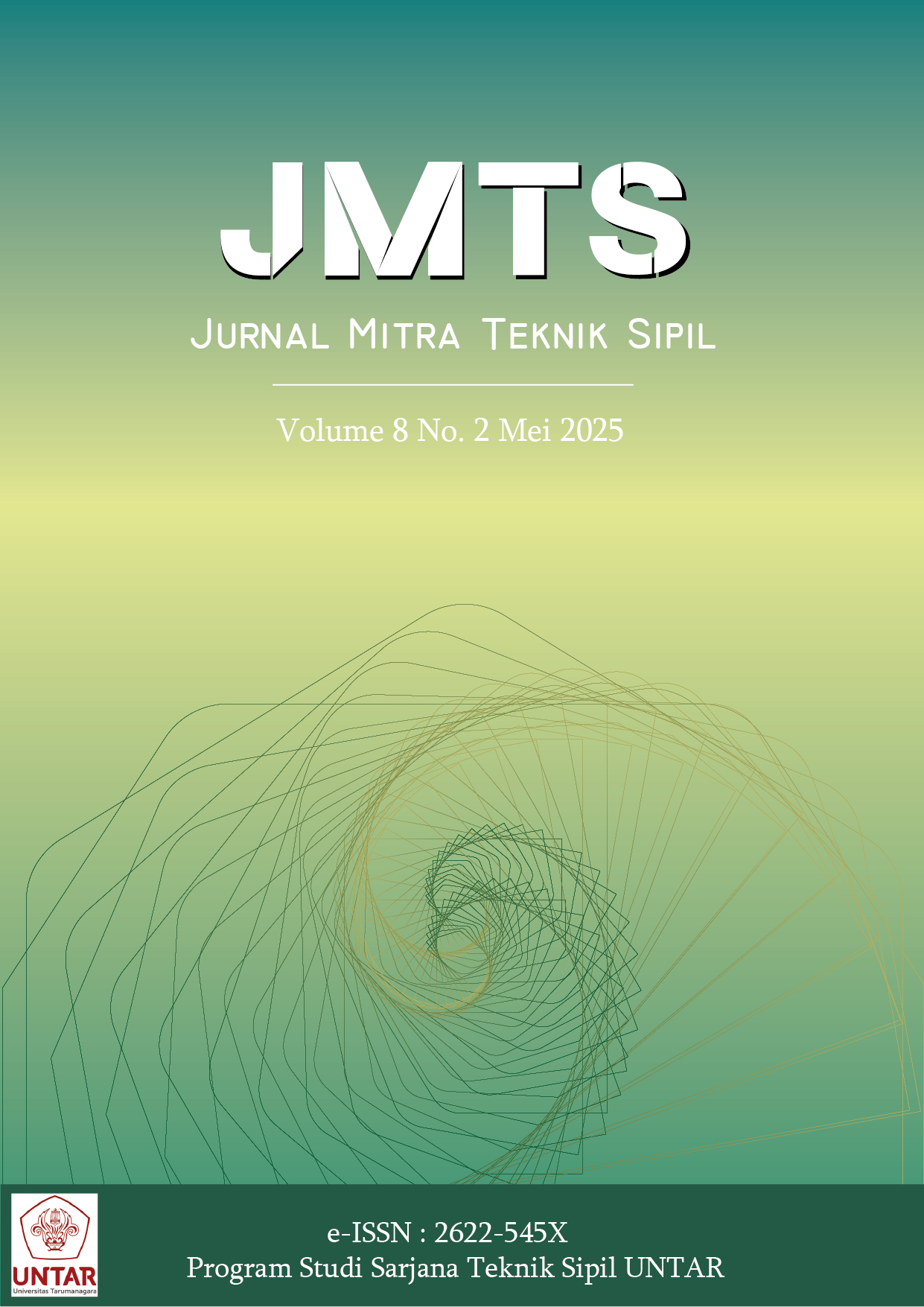ANALISIS PENGARUH BESAR SUDUT KONFIGURASI STAGGERED BOLT PADA BATANG TARIK MENGGUNAKAN APLIKASI MIDAS FEA NX
Main Article Content
Abstract
The angle variation of configuration bolts can influence stress and deflection factors. Therefore, it is necessary to analyze FEM toward its configuration by using MIDAS FEA NX. The sample experiment is a tensile steel plate with 20 mm thickness formed by bolts in five-by-five linear and staggered configurations with angles between bolts of 60, 45, and 30 degrees. All samples are pulled using the same distribution force with a value of 500 kN. All samples' nearest bolt distance and hole diameter are 50 mm and 20 mm. The analysis type is linear. Analysis shows that the tensile/compressive stress and deflection values are smaller for holes perpendicular to the force from front to back. Analysis shows that the smaller the angle sample, the greater the tensile and compressive stress and deflection value. The sample formed as a linear pattern shows the best result due to the smallest stress value, significantly raising the stress hole from linear to a staggered 30-degree pattern at 59.38%.
Abstrak
Konfigurasi baut yang sudutnya bervariasi bisa memengaruhi faktor tegangan serta defleksi. Oleh karena itu, diperlukan untuk menganalisis FEM terhadap konfigurasi tersebut dengan menggunakan MIDAS FEA NX. Sampel tes berupa pelat baja tarik dengan ketebalan 20 mm yang terbentuk oleh baut dengan konfigurasi lima kali lima linear dan zig-zag bersudut antar baut 60, 45, dan 30 derajat. Semua sampel ditarik dengan gaya distribusi yang sama sebesar 500 kN. Jarak baut terdekat dan diameter lubang pelat untuk semua sampel adalah 50 mm dan 20 mm. Tipe analisis berupa linear. Analisis menunjukkan nilai tegangan tarik/tekan dan defleksi semakin kecil untuk lubang yang tegak lurus gaya dari depan ke belakang. Analisis menunjukkan bahwa semakin mengecil sudut sampel, semakin besar nilai tegangan tarik, tegangan tekan, dan defleksi. Sampel konfigurasi linear menunjukkan hasil yang paling baik sebab memiliki nilai tegangan yang paling kecil, secara signifikan kenaikan tegangan lubang dari sampel berpola linear terhadap zig-zag 30 derajat yakni 59,38%.
Article Details

This work is licensed under a Creative Commons Attribution-NonCommercial-ShareAlike 4.0 International License.
This work is licensed under Jurnal Mitra Teknik Sipil (JMTS) Creative Commons Attribution-ShareAlike 4.0 International License.References
E., D., & Siyal, P. S. (2019). Numerical and analytical analysis of SCF for a rectangular plate with discontinuities holes for static loading. International Journal of Scientific Research in Multidisciplinary Studies, 5(12), 6-11.
Falcinelli, C., Valente, F., Vasta, M., & Traini, T. (2023). Finite element analysis in implant dentistry: State of the art and future directions. Dental Materials, 39(6), 539-556. doi:https://doi.org/10.1016/j.dental.2023.04.002
Freitas, S. T. (2005). Experimental research project on bolted connections in bearing for high strength steel. Archives Steel Structures.
Halim, K. T., & Leman, S. (2024). Analisis distribusi tegangan arah horizontal dengan sambungan baut pada pelat tarik menggunakan software autodesk inventor. JMTS, 7(1), 123-136. doi:https://doi.org/10.24912/jmts.v7i1.24946
Hibbeler, R. (2017). Mechanics of materials (10th ed.). Pearson.
Kiymaz, G. (2009). Investigations on the bearing strength of stainless steel bolted plates under in-plane tension. Steel and Composite Structures, 9(2), 173-189. doi:https://doi.org/10.12989/scs.2009.9.2.173
Leman, S., Christianto, D., & Tavio. (2023). Analisis prilaku dan distribusi tegangan pada sambungan pelat tarik dengan aplikasi finite element. Konferensi Nasional Teknik Sipil (KoNTekS), 1(3), 487-505. doi:https://doi.org/10.62603/konteks.v1i3.51
Logan, D. L. (2007). A first course in the finite element method (4th ed.). Thomson.
More, S. T., & Bindu, R. S. (2015). Effect of Mesh Size on Finite Element Analysis. International Journal of Engineering Science and Innovative Technology (IJESIT), 4(3), 181-185.
Sayed, A. M., Ang, W. L., Jedi, A., Lohgheswary, N., & Lubis, R. (2021). Tensile capacity of steel plate connections with different bolt distribution due to tensile load. Journal of Engineering Science and Technology, 16(2), 888-902.
Spiegel, L., & Limbrunner, G. F. (1993). Applied structural steel design (2nd ed.). Prentice Hall.



